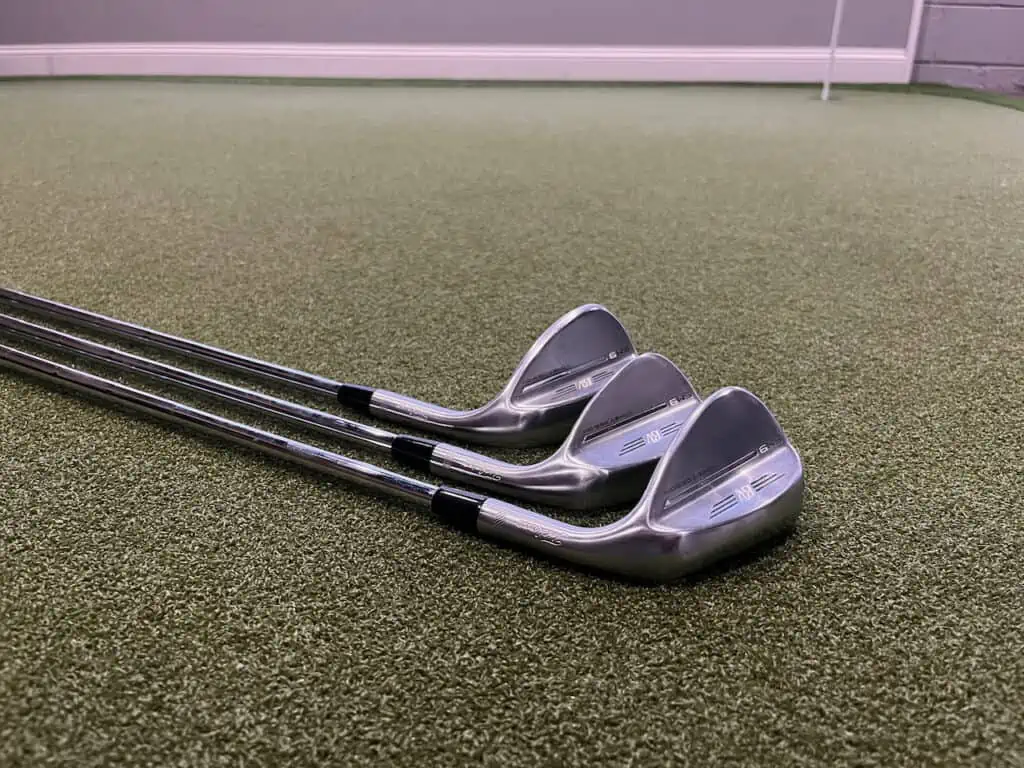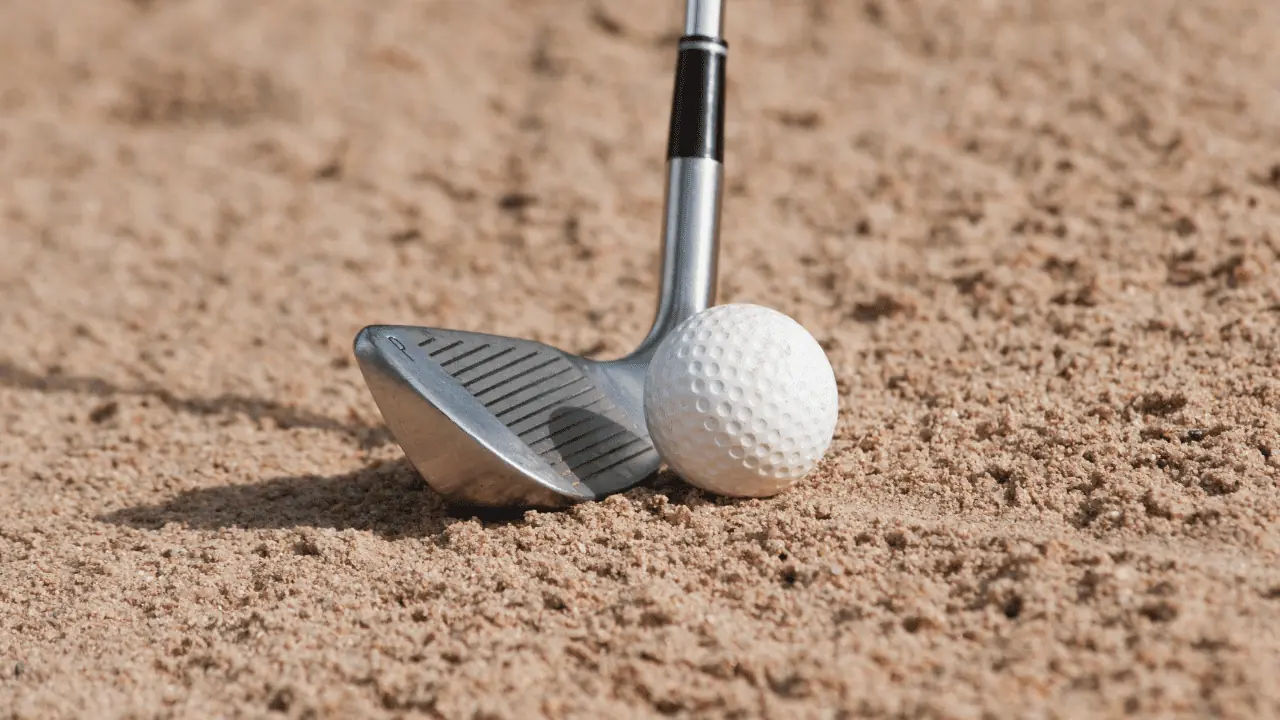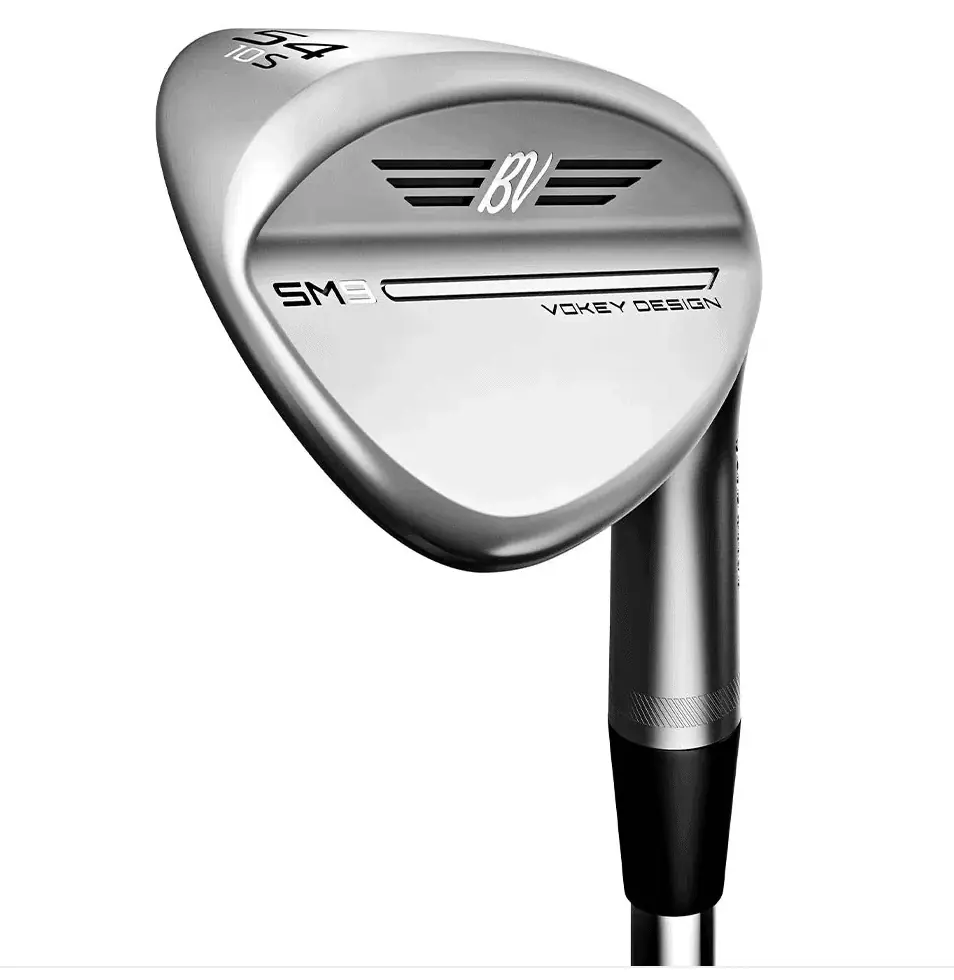Table of Contents
How many wedges should you carry is a common question for golfers. Read on for a better understanding of the various golf wedges.
Simple…and Long Answer
The simple answer to how many wedges should you carry is 3 at a minimum.
While I highly recommend carrying a minimum of 3 golf wedges for optimal short-game versatility, the average golfer can get away with 2 options.
However, the true answer is that it rests entirely on you. I have compiled this guide to highlight the features and benefits of each wedge to enable you to make better-informed decisions.
By the end of this post, you will know whether you should bridge the gap between your pitching and sand wedge with an approach wedge or enjoy a higher launch from a lob wedge. In addition, I explain what to consider when making your decision for more efficient chips, flops, pitches, and bunker shots.
⛳️ Read Next: 11 Best Golf Wedges to Shave Off Strokes
Types of Golf Wedges

Golf club manufacturers such as Titleist Vokey (shown above) produce four golf wedges with varied degrees of loft. These are pitching, gap, sand, and lob wedge. Each wedge is made for different launches, spin, and distances. I dive into the details of each model below and discuss their lofts and optimal shots.
🏌️♂️ Read Next: Best Golf Wedge Degrees for Chip, Flop, & Bunker Shots
Pitching Wedge
A pitching wedge is your most common option and is typically included in iron sets. This wedge is vital for your setup as it ensures a smooth transition from short irons to wedges. The average game-improvement golf wedge features 43 degrees of loft, while others are as strong as 41.5 degrees.
When your pitching wedge lofts are that strong, you likely need the assistance of a lower-lofted approach wedge. Otherwise, the gap between your pitching and sand wedge will be immense, leaving you with a hole in your arsenal on shorter full shots.
Gap Wedge
Many amateurs forego a gap wedge and opt for a pitching and sand wedge setup because it is how the stock set is sold. However, when the loft gap is excessive between the pitching and sand wedge, a gap wedge is handy.
For example, if you play a 43 degree pitching wedge and a 54 degree sand wedge, you lack 11 degrees in your set.
In my experience, my distance reduces by an average of 2 yards for every degree of loft. That means a missing gap wedge can lead to a 22-yard hole in your setup. As a result, you are left with the choice of a softer pitching wedge or giving a sand wedge everything you have.
Golfers who carry a 43 or 41.5 degree pitching wedge should stick to a 50-degree gap wedge to avoid excessive crevices in their yardage. Conversely, players swinging a 45 or 46 degree pitching wedge may opt for the weaker 52 degree gap wedge.
Sand Wedge
A sand wedge is a commonly used wedge because it is versatile and often included in a set of irons. These golf clubs are sold in a 54 or 56-degree loft profile and help you achieve more spin, play flops, chips, pitches, and, as the name suggests, for bunker shots.
For most amateurs, the sand wedge lofts are as weak as one can handle before you start ballooning shots and losing distance control and accuracy.
Lob Wedge
Lob wedges are handy golf clubs that help you get under the ball, launch it high and stop it dead for pinpoint accuracy.
Many lower handicappers welcome the setup of a lob wedge. On the other hand, many mid and high handicappers find the club troubling due to skied shots and shanks. Once you know how to control a lob wedge, it can help you escape trouble and hold the tightest greens out there.
However, it takes time to understand this club and its benefits, and best left to more skillful players.
🏌️♂️ Read Next: 16 Best Backyard Golf Practice Tools & Tips
How Do I Decide What Wedges I Should Carry?
The key factors impacting your wedges decision boil down to loft gaps and your most prominent short-game shots. Plus, your long game selection determines whether you have space for three or more wedges.
Golf Long Game Setup
The more clubs you throw in at the top end of your bag, the fewer slots you leave for wedges. While we all desire maximum long-game distance, don’t compromise your short game by adding more long-game clubs than necessary.
Stick to a balanced setup such as a driver, 3 wood, 5 wood, 3 hybrid, 4 hybrid, 5, 6, 7, 8, and 9 iron. With this setup, you leave space for three wedges to ensure maximum versatility and distance gapping in your wedges.
Wedge Loft Gaps
Golfers need a smooth transition between each club to ensure maximum distance and launch. Start by looking at your 9 iron loft and work forward. If your 9 iron contains 37 degrees of loft, you want a pitching wedge no weaker than 43 degrees.
Since your sand wedge is set at 54 degrees, you may require bridging a 50 degree gap wedge to plug any holes. If you only had space for three wedges, then that solves your dilemma without the need for much thought.
However, if you have space for a fourth wedge, you could add a 60 degree lob wedge for superior flop shots, a high launch, and a soft landing.
Wedge Shots
While I recommend you practice all short game shots to arm your game with a bunch of strokes, some golfers prefer playing certain wedge shots to others. As a result, you need the correct wedge to execute.
⛳️ Read Next: 20 Best Golf Training Aids in 2023 [Golf Expert Review]
Full Wedge Shots
Full wedge shots are a given with wedges, and your pitching wedge is the club you will use the most in these scenarios. However, sometimes a pitching wedge may offer excess club strength, and you need a weaker lofted wedge.
At my home course, I often find myself too close for a full shot but too far for a full sand wedge. I have learned to carry a gap wedge to help fill holes between the sand and pitching, allowing an easy swing.
Pitch Shots
Golfers can execute pitch shots with any wedge. However, I find a gap or pitching wedge gives me the distance control I need for efficient results. However, on closer-range pitch shots, a sand wedge works well.
Therefore, you only require two wedges to execute a successful pitch shot, whether a pitching, gap, or sand wedge.
Flop Shots
The average senior golfer produces superior flop shots with a sand or lob wedge. The 60-degree lob wedge is my preferred option, but the average player may balloon their strikes and lose control with the lob wedge.
As a result, I feel most players are better suited to swinging a sand wedge for flops than a lob wedge.
Chip Shots
Senior golfers get on well with a sand wedge or golf chipper club, which offers the feel, spin, and roll for added control on greenside shots. My lob wedge is my go-to, but the average player gets excessive airtime on chips relinquishing ball roll and control.
If chip shots are not going in your favor, consider playing a bump and run with the lower lofted, longer shafted pitching wedge.
Bunker Shots
The average senior golfer finds it easier to catch sand first and cleanly get the golf ball out of the bunker with a sand wedge. Usually, these sand wedges carry a versatile sole that makes it easy to open the clubface and strike the ball cleanly from any lie.
I also use my 60 degree lob wedge for bunker shots because of the high loft and added spin. However, once again, many golf players may struggle with the lack of forgiveness and increased launch of a lob wedge.
Read Next: Most Forgiving Wedges to Enhance Your Short Game
Frequently Asked Questions (FAQ)
How Many Wedges Do Most Pros Carry?
On average most pros carry 3 wedges in their bag to ensure a versatile setup that can cover any shot from the fairway or rough. From time to time, you may find pros carrying four wedges. However, that means sacrificing a longer club which impacts your distance at the top of the bag.
What 2 Wedges Should I Have in My Bag?
The 2 wedges every golfer should have in their bag are a pitching wedge and a sand wedge. Between these two clubs, you have enough tools for full shots, chips, flops, bunker shots, pitches, and bump and runs.
What 3 Degree Wedges Should I Carry?
If you could choose 3 wedges, I suggest a pitching, gap, and sand wedge. The pitching wedge ensures a seamless transition from irons to wedges. The gap wedge bridges any holes between your pitching and sand wedge.
Finally, a sand wedge gives you a versatile option that chips well, escapes the bunker, and proves handy on flop shots.
Final Thoughts: How Many Wedges Should You Carry?
As I stated at the outset, the answer to how many wedges I should carry is not straightforward. It comes down to your ideal preference, loft gaps, and the shots you prefer playing around the green.
While I highly recommend carrying a minimum of 3 wedges for optimal short-game versatility, the average golfer can get away with 2 options. As long as you have a pitching and sand wedge, you can play full wedge shots, pitch shots, flops, chips, bump and runs, and bunker shots.


